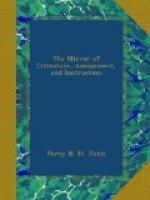tremble at a gallopade, or fall prostrate under the
inflictions of “the parson’s farewell,”
or “the wind that shakes the barley.”
The system of building, or rather “running up”
a house first, and afterwards providing it with a false
exterior, meant to deceive the eye with the semblance
of curved stone, is in itself an absolute abomination.
Besides, Greek architecture, so magnificent when on
a large scale, becomes perfectly ridiculous when applied
to a private street-mansion, or a haberdasher’s
warehouse. St. Paul’s Church, Covent-Garden,
is an instance of the unhappy effect produced by a
combination of a similar kind; great in all its parts,
with its original littleness, it very nearly approximates
to the character of a barn. Inigo Jones doubtless
desired to erect an edifice of stately Roman aspect,
but he was cramped in his design, and, therefore,
only aspired to make a first-rate barn; so far unquestionably
the great architect has succeeded. Then looking
to those details of London architecture, which appear
more peculiarly connected with the dignity of the
nation, what can we say of it, but that the King of
Great Britain is worse lodged than the chief magistrate
of Claris or Zug, while the debates of the most powerful
assembly in the world are carried on in a building,
(or, a return to Westminster Hall,) which will bear
no comparison with the Stadthouse at Amsterdam!
The city, however, as a whole, presents a combination
of magnitude and grandeur, which we should in vain
look for elsewhere, although with all its immensity
it has not yet realized the quaint prediction of James
the First,—that London would shortly be
England, and England would be London.
Morning.
The metropolis presents certain features of peculiar
interest just at that unpopular dreamy hour when stars
“begin to pale their ineffectual fires,”
and the drowsy twilight of the doubtful day brightens
apace into the fulness of morning, “blushing
like an Eastern bride.” Then it is that
the extremes of society first meet under circumstances
well calculated to indicate the moral width between
their several conditions. The gilded chariot
bowls along from square to square with its delicate
patrimonial possessor, bearing him homeward in celerity
and silence, worn with lassitude, and heated with wine
quaffed at his third rout, after having deserted the
oft-seen ballet, or withdrawn in pettish disgust at
the utterance of a false harmony in the opera.
A cabriolet hurries past him still more rapidly, bearing
a fashionable physician, on the fret at having been
summoned prematurely from the comforts of a second
sleep in a voluptuous chamber, on an experimental
visit to
“Raise the weak head, and stay the
parting sigh,
Or with new life relume the swimming eye.”
At the corners of streets of traffic, and more especially
“Where fam’d St. Giles’s
ancient limits spread,”




